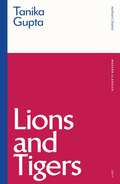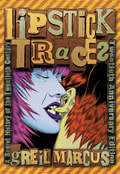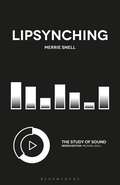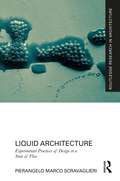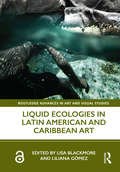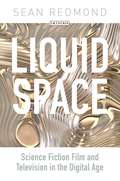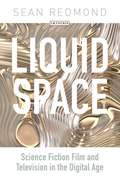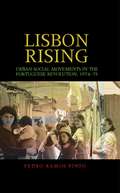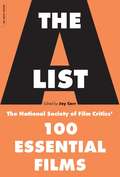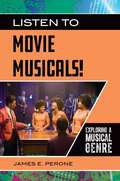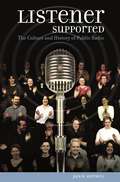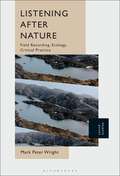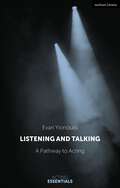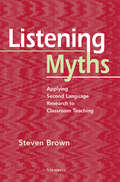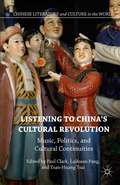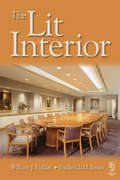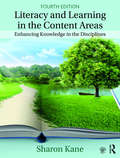- Table View
- List View
Lions and Tigers (Modern Classics)
by Tanika Gupta"Tanika Gupta's epic drama pushes the boundaries of verbatim theatre, telling an important story in a fresh and authentic way never seen on stage before. A rousing piece of work." - Greg Walker, Regius Professor of Rhetoric and English Literature, University of Edinburgh, UK. Based on the true story of Tanika Gupta's great uncle, Lions and Tigers follows nineteen-year-old Dinesh Gupta's emotional and political awakening as a freedom fighter pitting himself against the British Raj.Drawn from family stories that the playwright herself heard from early childhood, the play teems with details drawn from her grandfather's 500-page handwritten journal about his younger brother, and from the 92 letters written by her great uncle from his prison cell.Set against the backdrop of negotiations between the leaders of the Indian National Congress and culminating in actions that shook the very foundations of the British Empire, Lions and Tigers challenges our assumptions about Indian independence and offers powerful new insights into the battles between the British lions and the Bengal tigers. The play was first performed at Shakespeare's Globe from the 23rd August to 16th September 2017, and was awarded the James Tait Black Prize for Drama in 2018. It is published here in Methuen Drama's Modern Classics series for the first time, with a brand new introduction.
Lipstick Traces: A Secret History Of The Twentieth Century
by Greil MarcusThis is a secret history of modern times, told by way of what conventional history tries to exclude. Lipstick Traces tells a story as disruptive and compelling as the century itself.
Lipsynching (The Study of Sound)
by Merrie SnellWhat does it mean when a singing voice is detached from an originating body through recording? And how does this affect consumers of recorded song? This book examines the practice of lipsynching to pre-recorded song in both professional and vernacular contexts, covering over a century of diverse artistic practices from early cinema through to the current popularity of self-produced internet lipsynching videos. It examines the ways in which we listen to, respond to, and use recorded music, not only as a commodity to be consumed but as a culturally-sophisticated and complex means of identification, a site of projection, introjection, and habitation, and, through this, a means of personal and collective creativity.
Lipsynching (The Study of Sound)
by Merrie SnellWhat does it mean when a singing voice is detached from an originating body through recording? And how does this affect consumers of recorded song? This book examines the practice of lipsynching to pre-recorded song in both professional and vernacular contexts, covering over a century of diverse artistic practices from early cinema through to the current popularity of self-produced internet lipsynching videos. It examines the ways in which we listen to, respond to, and use recorded music, not only as a commodity to be consumed but as a culturally-sophisticated and complex means of identification, a site of projection, introjection, and habitation, and, through this, a means of personal and collective creativity.
Liquid Architecture: Experimental Practices of Design in a State of Flux (Routledge Research in Architecture)
by Pierangelo Marco ScravaglieriLiquid Architecture challenges the idea of architecture as a fixed, inert container and reconceptualises it as a body whose boundaries are rather blurred and ever-changing. This book moves away from form as the primary driver of spatial protocols and explores what the built environment might look like when viewed through the lenses of a ‘wet ontology’ that is attentive to fluidity, flows and territorial dynamism. A reconfiguration of architectural materials and authorship is thus considered, leading, in turn, to an exploration of the ethical dimensions of co-designing with natural systems (of various viscosities) through liquid paradigms. The book examines a set of principles for practice-led discoveries that incorporate hybrid, mixed media with the author’s intersubjective relationship with liquid matter. Drawing from qualitative-based analytical investigation models, the text allows comprehension of the liquid phenomena via material contextualisation of an ever-becoming research setting. Through a practical and theoretical engagement with the ontology of liquids, the reader is exposed to a range of design-led experiments and creative propositions, visualisation systems, construction, and testing of physical models that collectively translate into a series of novel insights for architectural agendas. This book will be of interest to architecture and design research students and academics because it advocates the need for a more symbiotic and resilient approach to natural systems, which could benefit from the integration of regenerating material flows into our buildings and urban settlements.
Liquid Architecture: Experimental Practices of Design in a State of Flux (Routledge Research in Architecture)
by Pierangelo Marco ScravaglieriLiquid Architecture challenges the idea of architecture as a fixed, inert container and reconceptualises it as a body whose boundaries are rather blurred and ever-changing. This book moves away from form as the primary driver of spatial protocols and explores what the built environment might look like when viewed through the lenses of a ‘wet ontology’ that is attentive to fluidity, flows and territorial dynamism. A reconfiguration of architectural materials and authorship is thus considered, leading, in turn, to an exploration of the ethical dimensions of co-designing with natural systems (of various viscosities) through liquid paradigms. The book examines a set of principles for practice-led discoveries that incorporate hybrid, mixed media with the author’s intersubjective relationship with liquid matter. Drawing from qualitative-based analytical investigation models, the text allows comprehension of the liquid phenomena via material contextualisation of an ever-becoming research setting. Through a practical and theoretical engagement with the ontology of liquids, the reader is exposed to a range of design-led experiments and creative propositions, visualisation systems, construction, and testing of physical models that collectively translate into a series of novel insights for architectural agendas. This book will be of interest to architecture and design research students and academics because it advocates the need for a more symbiotic and resilient approach to natural systems, which could benefit from the integration of regenerating material flows into our buildings and urban settlements.
Liquid Ecologies in Latin American and Caribbean Art (Routledge Advances in Art and Visual Studies)
by Lisa Blackmore Liliana GómezThis interdisciplinary book brings into dialogue research on how different fluids and bodies of water are mobilised as liquid ecologies in the arts in Latin America and the Caribbean. Examining the visual arts, including multimedia installations, performance, photography and film, the chapters place diverse fluids and systems of flow in art historical, ecocritical and cultural analytical contexts. The book will be of interest to scholars of art history, cultural studies, environmental humanities, blue humanities, ecocriticism, Latin American and Caribbean studies, and island studies.
Liquid Ecologies in Latin American and Caribbean Art (Routledge Advances in Art and Visual Studies)
by Lisa Blackmore Liliana GómezThis interdisciplinary book brings into dialogue research on how different fluids and bodies of water are mobilised as liquid ecologies in the arts in Latin America and the Caribbean. Examining the visual arts, including multimedia installations, performance, photography and film, the chapters place diverse fluids and systems of flow in art historical, ecocritical and cultural analytical contexts. The book will be of interest to scholars of art history, cultural studies, environmental humanities, blue humanities, ecocriticism, Latin American and Caribbean studies, and island studies.
Liquid Space: Science Fiction Film and Television in the Digital Age
by Sean RedmondIn this remarkable and original book, Sean Redmond examines the issues and themes that are repeatedly found across a range of contemporary science fiction films and television programmes. He argues that they reveal the profound effects the digital age has had on our social lives. Through narratives that feature the 'post-human', genetic engineering and cloning, surveillance and data mining, space and time travel, artificial intelligence, online dating cultures and visions of catastrophe, they portray a world in which the material, and the stable, are being lost to the ever-more volatile and ephemeral idea of 'liquid space'. Redmond examines a wide selection of popular films and TV series such as Gravity, Under the Skin, The Lobster, Children of Men and Doctor Who, to locate how traditional values are being erased in favour of a new liquid modernity. Drawing on an eclectic range of approaches from phenomenology to critical race theory, and from close textual analysis to the revelations of eye-tracking technology, this book is an illuminating account of the digital age through the lens of science fiction.
Liquid Space: Science Fiction Film and Television in the Digital Age (International Library of the Moving Image (PDF))
by Sean RedmondScience fiction is perhaps the most effective genre to explore the concerns of the present whilst reflecting on the possibilities of the future. But what precisely can it tell us about present and future by setting these two timeframes in the same critical space?
Lisbon rising: Urban social movements in the Portuguese Revolution, 1974–75 (PDF)
by Pedro PintoLisbon rising explores the role of a widespread urban social movement in the revolutionary process that accompanied Portugal’s transition from authoritarianism to democracy. It is the first in-depth study of the widest urban movement of the European post-war period, an event that shook the balance of Cold War politics by threatening the possibility of revolution in Western Europe. Using hitherto unknown sources produced by movement organisations themselves, it challenges long-established views of civil society in Southern Europe as weak, arguing that popular movements had an important and autonomous role in the process that led to democratisation, inviting us to rethink the history and theories of transitions in the region in ways that account for popular agency. Lisbon rising will be of interest not only to students of twentieth-century European history, but across disciplines to students of democratisation, social movements and citizenship in political science and sociology.
Lisbon rising: Urban social movements in the Portuguese Revolution, 1974–75
by Pedro PintoLisbon rising explores the role of a widespread urban social movement in the revolutionary process that accompanied Portugal’s transition from authoritarianism to democracy. It is the first in-depth study of the widest urban movement of the European post-war period, an event that shook the balance of Cold War politics by threatening the possibility of revolution in Western Europe. Using hitherto unknown sources produced by movement organisations themselves, it challenges long-established views of civil society in Southern Europe as weak, arguing that popular movements had an important and autonomous role in the process that led to democratisation, inviting us to rethink the history and theories of transitions in the region in ways that account for popular agency. Lisbon rising will be of interest not only to students of twentieth-century European history, but across disciplines to students of democratisation, social movements and citizenship in political science and sociology.
A List: The National Society Of Film Critics' 100 Essential Films
by Jay CarrPeople love movies. People love lists. So The A-List is a natural. While there are plenty of encyclopedic lists of films, this compulsively readable book of 100 essays -- most written expressly for this volume-flags the best of the best as chosen by a consensus of the National Society of Film Critics. The Society is a world-renowned, marquee -- name organization embracing some of America's most distinguished critics: more than forty writers who have national followings as well as devoted local constituencies in such major cities as New York, Chicago, Los Angeles, Boston, Philadelphia, Atlanta, and Minneapolis. But make no mistake about it: This isn't a collection of esoteric "critic's choice" movies. The Society has made its selections based on a film's intrinsic merits, its role in the development of the motion-picture art, and its impact on culture and society. Some of the choices are controversial. So are some of the omissions. It will be a jumping-off point for discussions for years to come. And since the volume spans all international films from the very beginning, it will act as a balance to recent guides dominated by films of the last two decades (hardly film's golden age). Here is a book that is definitely ready for its close-up.
Listen to Movie Musicals!: Exploring a Musical Genre (Exploring Musical Genres)
by James E. PeroneListen to Movie Musicals! provides an overview of musical theater on film for fans of the genre, with a focus on 50 must-hear musicals featured in movies.Listen to Movie Musicals! includes an overview of musical theatre and movie musicals in the United States. The 50 movies chosen for critical analysis include many of the best-known film musicals of the past and present; however, the list also includes several important movie musicals that were popular successes that are not necessarily on the "best-of" lists in other books. This volume also includes a greater focus on the actual music of movie musicals than do most other books, making it a stand-out title on the topic for high school and college readers. Like the other books in this series, this volume includes a background chapter followed by a chapter that contains 50 important essays on must-hear movie musicals of approximately 1,500 words each. Chapters on the impact of movie musicals on popular culture and the legacy of movie musicals further explain the impact of both the movies and their songs.
Listen to Movie Musicals!: Exploring a Musical Genre (Exploring Musical Genres)
by James E. PeroneListen to Movie Musicals! provides an overview of musical theater on film for fans of the genre, with a focus on 50 must-hear musicals featured in movies.Listen to Movie Musicals! includes an overview of musical theatre and movie musicals in the United States. The 50 movies chosen for critical analysis include many of the best-known film musicals of the past and present; however, the list also includes several important movie musicals that were popular successes that are not necessarily on the "best-of" lists in other books. This volume also includes a greater focus on the actual music of movie musicals than do most other books, making it a stand-out title on the topic for high school and college readers. Like the other books in this series, this volume includes a background chapter followed by a chapter that contains 50 important essays on must-hear movie musicals of approximately 1,500 words each. Chapters on the impact of movie musicals on popular culture and the legacy of movie musicals further explain the impact of both the movies and their songs.
Listener Supported: The Culture and History of Public Radio (Non-ser.)
by Jack W. MitchellPublic radio stands as a valued national institution, one whose fans and listeners actively support it with their time and their money. In this new history of this important aspect of American culture, author Jack W. Mitchell looks at the dreams that inspired those who created it, the all-too- human realities that grew out of those dreams, and the criticism they incurred from both sides of the political spectrum. As National Public Radio's very first employee, and the first producer of its legendary All Things Considered, Mitchell tells the story of public radio from the point of view of an insider, a participant, and a thoughtful observer. He traces its origins in the progressive movement of the 20th century, and analyzes the people, institutions, ideas, political forces, and economic realities that helped it evolve into what we know as public radio today. NPR and its local affiliates have earned their reputation for thoughtful commentary and excellent journalism, and their work is especially notable in light of the unique struggles they have faced over the decades. This comprehensive overview of their mission will fascinate listeners whose enjoyment and support of public radio has made it possible, and made it great.
Listening After Nature: Field Recording, Ecology, Critical Practice
by Mark Peter WrightListening After Nature examines the constructions and erasures that haunt field recording practice and discourse. Analyzing archival and contemporary soundworks through a combination of post-colonial, ecological and sound studies scholarship, Mark Peter Wright recodes the Field; troubles conceptions of Nature; expands site-specificity; and unearths hidden technocultures. What exists beyond the signal? How is agency performed and negotiated between humans and nonhumans? What exactly is a field recording and what are its pedagogical potentials? These questions are operated by a methodology of listening that incorporates the spaces of audition, as well as Wright's own practice-based reflections. In doing so, Listening After Nature posits a range of novel interventions. One example is the “Noisy-Nonself,” a conceptual figuration with which to comprehend the presence of reticent recordists. “Contact Zones and Elsewhere Fields” offers another unique contribution by reimaging the relationship between the field and studio. In the final chapter, Wright explores the microphone by tracing its critical and creative connections to natural resource extraction and contemporary practice. Listening After Nature auditions water and waste, infrastructures and animals, technologies and recordists, data and stars. It grapples with the thresholds of sensory perception and anchors itself to the question: what am I not hearing? In doing so, it challenges Western universalisms that code the field whilst offering vibrant practice-based possibilities.
Listening After Nature: Field Recording, Ecology, Critical Practice
by Mark Peter WrightListening After Nature examines the constructions and erasures that haunt field recording practice and discourse. Analyzing archival and contemporary soundworks through a combination of post-colonial, ecological and sound studies scholarship, Mark Peter Wright recodes the Field; troubles conceptions of Nature; expands site-specificity; and unearths hidden technocultures. What exists beyond the signal? How is agency performed and negotiated between humans and nonhumans? What exactly is a field recording and what are its pedagogical potentials? These questions are operated by a methodology of listening that incorporates the spaces of audition, as well as Wright's own practice-based reflections. In doing so, Listening After Nature posits a range of novel interventions. One example is the “Noisy-Nonself,” a conceptual figuration with which to comprehend the presence of reticent recordists. “Contact Zones and Elsewhere Fields” offers another unique contribution by reimaging the relationship between the field and studio. In the final chapter, Wright explores the microphone by tracing its critical and creative connections to natural resource extraction and contemporary practice. Listening After Nature auditions water and waste, infrastructures and animals, technologies and recordists, data and stars. It grapples with the thresholds of sensory perception and anchors itself to the question: what am I not hearing? In doing so, it challenges Western universalisms that code the field whilst offering vibrant practice-based possibilities.
Listening and Talking: A Pathway to Acting (Acting Essentials)
by Ms Evan YionoulisListening and Talking: A Pathway to Acting provides undergraduate acting students with a clear, achievable, step-by-step way to approach the work of playing a role. The text is supplemented by exclusive video material to take the actor from their first encounter with the text through rehearsals with fellow actors and into performance. Drawing from the author's twenty years' experience of teaching at the Yale School of Drama, this book, which is influenced, too, by the work of legendary teachers such as Konstantin Stanislavski and Uta Hagen, presents a thorough examination of key aspects of the actor's technique (for example, listening, playing an action and pursuing an objective). Throughout, it includes exercises and process points through which students can put into practice the key lessons from each chapter.The practices laid out in this book form a holistic curriculum that not only ensures measurable results over a semester- or year-long course, but also sets in motion an internal process that will serve the student over their life as an artist.
Listening and Talking: A Pathway to Acting (Acting Essentials)
by Ms Evan YionoulisListening and Talking: A Pathway to Acting provides undergraduate acting students with a clear, achievable, step-by-step way to approach the work of playing a role. The text is supplemented by exclusive video material to take the actor from their first encounter with the text through rehearsals with fellow actors and into performance. Drawing from the author's twenty years' experience of teaching at the Yale School of Drama, this book, which is influenced, too, by the work of legendary teachers such as Konstantin Stanislavski and Uta Hagen, presents a thorough examination of key aspects of the actor's technique (for example, listening, playing an action and pursuing an objective). Throughout, it includes exercises and process points through which students can put into practice the key lessons from each chapter.The practices laid out in this book form a holistic curriculum that not only ensures measurable results over a semester- or year-long course, but also sets in motion an internal process that will serve the student over their life as an artist.
Listening Myths: Applying Second Language Research to Classroom Teaching
by Steven BrownThis volume was conceived as a "best practices" resource for teachers of ESL listening courses in the way that Vocabulary Myths by Keith S. Folse (and Writing Myths by Joy Reid) is one for reading and vocabulary teachers. It was written to help ensure that teachers of listening are not perpetuating the myths of teaching listening. Both the research and pedagogy in this book are based on the newest research in the field of second language acquisition. Steven Brown is the author of the Active Listening textbook series and is a teacher trainer. The myths debunked in this book are: § Listening is the same as reading. § Listening is passive. § Listening equals comprehension. § Because L1 language ability is effortlessly acquired, L2 listening ability is too. § Listening means listening to conversations. § Listening is an individual, inside-the-head process. § Students should only listen to authentic materials. § Listening can’t be taught.
Listening to China’s Cultural Revolution: Music, Politics, and Cultural Continuities (Chinese Literature and Culture in the World)
by Paul Clark Laikwan Pang Tsan-Huang TsaiBringing together the most recent research on the Cultural Revolution in China, musicologists, historians, literary scholars, and others discuss the music and its political implications. Combined, these chapters, paint a vibrant picture of the long-lasting impact that the musical revolution had on ordinary citizens, as well as political leaders.
Lit Interior
by Frederick H Jones William J FielderPresents an organised, comprehensive and easy to understand overview of the lighting design process. It covers every topic from the nature of light itself, through selecting the correct equipment, to preparing project plans and the finished design documents.Using a dummy example the student is taken through an entire project step by step where the full range of alternatives and design processes are illustrated. The easy to read conversational tone makes the novice feel at home with complex technical concepts and provides an excellent introduction to all newcomers to the subject. The book is ideal for those working in architecture, electrical engineering and interior design who will one day design lighting systems for others to build.A companion website runs alongside the book, at http://litinterior.com/, supporting distance learning projects, providing manufacturers data, calculation engines and downloadable courses for carrying our design exercises. The content of the courses will be linked directly to the book.Includes US codes and standards.
Lit Interior
by Frederick H Jones William J FielderPresents an organised, comprehensive and easy to understand overview of the lighting design process. It covers every topic from the nature of light itself, through selecting the correct equipment, to preparing project plans and the finished design documents.Using a dummy example the student is taken through an entire project step by step where the full range of alternatives and design processes are illustrated. The easy to read conversational tone makes the novice feel at home with complex technical concepts and provides an excellent introduction to all newcomers to the subject. The book is ideal for those working in architecture, electrical engineering and interior design who will one day design lighting systems for others to build.A companion website runs alongside the book, at http://litinterior.com/, supporting distance learning projects, providing manufacturers data, calculation engines and downloadable courses for carrying our design exercises. The content of the courses will be linked directly to the book.Includes US codes and standards.
Literacy and Learning in the Content Areas: Enhancing Knowledge in the Disciplines
by Sharon KaneThe Fourth Edition of Literacy and Learning in the Content Areas: Enhancing Knowledge in the Disciplines provides readers with the knowledge, motivation, tools, and confidence for integrating literacy in their disciplinary classrooms. Offering an original, literature-based approach to teaching disciplinary literacy, the new edition shares important ways in which teachers of courses in the disciplines can enhance student learning of subject matter and skills while also fostering their growth in the many facets of literacy. Throughout each chapter, Kane provides engaging and creative strategies and activities to make literacy come alive in discipline-specific courses and to encourage students to explore and learn in the classroom. Embedded in each chapter are examples, resources, and strategies to help readers actively engage with and implement literacy practices. These features include Teaching in Action examples by subject area; Activating Prior Knowledge activities to stimulate critical thinking to prepare readers to learn complex theoretical and conceptual material about teaching, learning, and literacy; and end-of-chapter Application Activities to apply field experiences to classroom use. New to the Fourth Edition Every chapter of this new edition is updated to reflect the current approaches, standards, and benchmarks for discipline-specific literacy. Enhanced Companion Website with BookTalks to introduce relevant books in many genres and subjects, encouraging readers to explore the books for themselves and providing a model for BookTalks in their own classrooms. Expanded practical instructional strategies for teaching literacy in math, science, and social studies. Updated to include newly published titles in children’s literature, young adult literature, and nonfiction.
